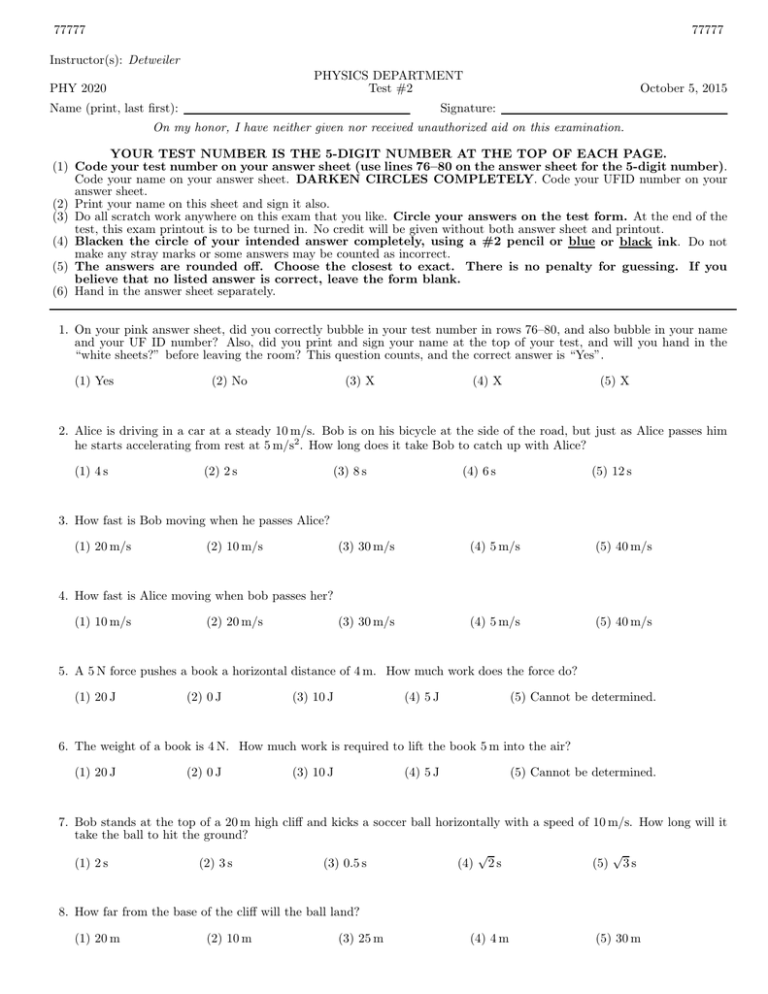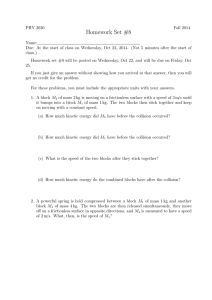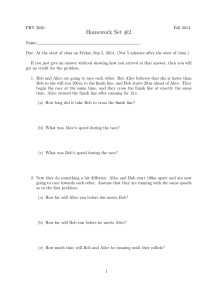77777 Instructor(s): Detweiler PHYSICS DEPARTMENT PHY 2020
advertisement

77777 77777 Instructor(s): Detweiler PHYSICS DEPARTMENT Test #2 PHY 2020 October 5, 2015 Signature: Name (print, last first): On my honor, I have neither given nor received unauthorized aid on this examination. YOUR TEST NUMBER IS THE 5-DIGIT NUMBER AT THE TOP OF EACH PAGE. (1) Code your test number on your answer sheet (use lines 76–80 on the answer sheet for the 5-digit number). Code your name on your answer sheet. DARKEN CIRCLES COMPLETELY. Code your UFID number on your answer sheet. (2) Print your name on this sheet and sign it also. (3) Do all scratch work anywhere on this exam that you like. Circle your answers on the test form. At the end of the test, this exam printout is to be turned in. No credit will be given without both answer sheet and printout. (4) Blacken the circle of your intended answer completely, using a #2 pencil or blue or black ink. Do not make any stray marks or some answers may be counted as incorrect. (5) The answers are rounded off. Choose the closest to exact. There is no penalty for guessing. If you believe that no listed answer is correct, leave the form blank. (6) Hand in the answer sheet separately. 1. On your pink answer sheet, did you correctly bubble in your test number in rows 76–80, and also bubble in your name and your UF ID number? Also, did you print and sign your name at the top of your test, and will you hand in the “white sheets?” before leaving the room? This question counts, and the correct answer is “Yes”. (1) Yes (2) No (3) X (4) X (5) X 2. Alice is driving in a car at a steady 10 m/s. Bob is on his bicycle at the side of the road, but just as Alice passes him he starts accelerating from rest at 5 m/s2 . How long does it take Bob to catch up with Alice? (1) 4 s (2) 2 s (3) 8 s (4) 6 s (5) 12 s 3. How fast is Bob moving when he passes Alice? (1) 20 m/s (2) 10 m/s (3) 30 m/s (4) 5 m/s (5) 40 m/s (3) 30 m/s (4) 5 m/s (5) 40 m/s 4. How fast is Alice moving when bob passes her? (1) 10 m/s (2) 20 m/s 5. A 5 N force pushes a book a horizontal distance of 4 m. How much work does the force do? (1) 20 J (2) 0 J (3) 10 J (4) 5 J (5) Cannot be determined. 6. The weight of a book is 4 N. How much work is required to lift the book 5 m into the air? (1) 20 J (2) 0 J (3) 10 J (4) 5 J (5) Cannot be determined. 7. Bob stands at the top of a 20 m high cliff and kicks a soccer ball horizontally with a speed of 10 m/s. How long will it take the ball to hit the ground? √ √ (5) 3 s (1) 2 s (2) 3 s (3) 0.5 s (4) 2 s 8. How far from the base of the cliff will the ball land? (1) 20 m (2) 10 m (3) 25 m (4) 4 m (5) 30 m 77777 77777 9. Two carts, one of mass 2 kg and the other a mass 4 kg, are held on a frictionless track with a spring compressed between them. When the two carts are simultaneously released, the 2 kg mass moves with a speed of 2 m/s. How fast is the 4 kg mass moving in the opposite direction? (1) 1 m/s (2) 2 m/s (3) 3 m/s (4) 4 m/s (5) 5 m/s 10. Two carts, one of mass 4 kgand the other mass 2 kg, are held on a frictionless track with a spring compressed between them. When the two carts are simultaneously released, the 4 kg mass moves with a speed of 1 m/s. How fast is the 2 kg mass moving in the opposite direction? (1) 2 m/s (2) 1 m/s (3) 3 m/s (4) 4 m/s (5) 5 m/s 11. A 2 kg block is sliding (on a frictionless surface) with a speed of 9 m/s when it collides with a second block of mass 4 kg which is initially at rest. The two blocks stick together in the collision. What is the speed of the combined blocks after the collision? (1) 3 m/s (2) 2 m/s (3) 0.5 m/s (4) 4 m/s (5) 6 m/s 12. After the collision, how much kinetic energy did the combined object have? (1) 27 J (2) 81 J (3) 36 J (4) 18 J (5) 45 J 13. How much work do you do if you lift an object of mass 10 kg off the ground to a height of 2 m? (1) 200 J (2) 100 J (3) 400 J (4) 20 J (5) None 14. How much work do you do if you very slowly carry this mass at the same height (2 m) to a new location 20 m away? (1) None (2) 100 J (3) 400 J (4) 20 J (5) 200 J 15. If you then drop the object and it falls to the ground, how fast will it be moving just before it hits the gound? √ √ √ √ (2) 2 3 m/s (3) 10 3 m/s (4) 3 2 m/s (5) 10 m/s (1) 2 10 m/s 16. A hand grenade initially at rest and with a mass of 3 kg explodes into two pieces. One piece has a mass of 1 kg and moves with a speed of 40 m/s. The mass of the second piece of the hand grenade is 2 kg. What is the speed of the 2 kg piece? (1) 20 m/s (2) 10 m/s (3) 40 m/s (4) 30 m/s (5) 50 m/s (4) 1600 J (5) 600 J (4) 1600 J (5) 600 J 17. What is the kinetic energy of the 1 kg mass after the explosion? (1) 800 J (2) 400 J (3) 200 J 18. What is the kinetic energy of the 2 kg mass after the explosion? (1) 400 J (2) 800 J (3) 200 J 77777 77777 19. A 10 kg block is held at the top of a frictionless slide. The top of the slide is 5 m above the ground. The length of the slide is 8 m. After the block is released, how fast will it be moving when it reaches the bottom of the slide? (1) 10 m/s (2) 5 m/s (3) 2 m/s (4) 20 m/s (5) 15 m/s 20. When the block was only halfway down the slide, how fast was it moving? Choose the number closest to the actual value! (1) 7 m/s (2) 3 m/s (3) 5 m/s (4) 2 m/s (5) 9 m/s THE FOLLOWING QUESTIONS, NUMBERED IN THE ORDER OF THEIR APPEARANCE ON THE ABOVE LIST, HAVE BEEN FLAGGED AS CONTINUATION QUESTIONS: 3 4 6 8 12 14 15 17 18 20 FOLLOWING GROUPS OF QUESTIONS WILL BE SELECTED AS ONE GROUP FROM EACH TYPE TYPE 1 Q# S 9 Q# S 10



